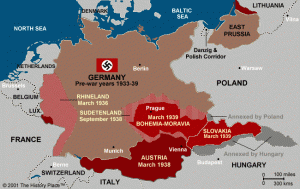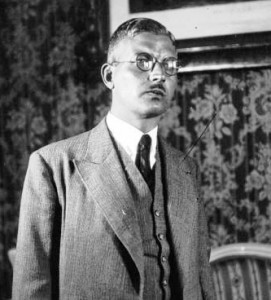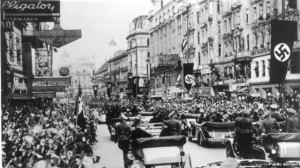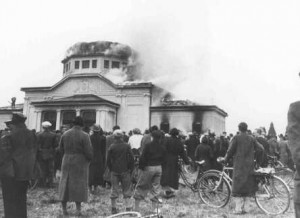State frontiers are established by human beings
and may be changed by human beings.
Adolf Hitler. Mein Kampf
Diplomacy, with all the conventions of its forms,
recognizes only real facts.
Charles de Gaulle
All of Adolf Hitler’s actions, from the time he rose to power in 1933 until 1939, could be described as one triumph after another. He met each challenge he faced: he took over as head of the country, returned Germany’s lost territories without a struggle, and was given permission from England and France to rearm. But one further task lay before him, and failure now would make his previous achievements almost pointless. The new, powerful, self-confident Germany needed to attack the USSR. Her army required a launching pad where she could deploy her army for invasion. Otherwise it would be impossible to take a stab at Russia. After all, it did not matter how many tanks and airplanes Hitler possessed or whether they were old or new, as long as Germany lacked a shared border with the Soviet Union. The diplomats of England and France wrestled with how to resolve this problem.

Until now, as in the case of the Saar and the Rhineland, Hitler had retaken lands that had previously belonged to the Kaiser’s empire, and Western politicians had for the most part granted him an “indulgence.” After all, the Germans were only recovering what was “theirs,” and thus we will avert our eyes.
However, now the situation had changed. Austria became Hitler’s first truly “foreign” victim. And it wasn’t because it was the birthplace of the future German Fuhrer, Adolf Schicklgruber. Nor will we mention the kinship between the ethnic Germans of Germany and Austria. We will leave this to the linguists and ethnographers to sort out. Our focus is elsewhere: for the first time Hitler used threats of coercion and force to compel the chancellor of the independent Austrian state to sign a treaty with Germany that effectively deprived the smaller country of its independence.
On February 11, 1938, Hitler summoned Austrian Chancellor Kurt von Schuschnigg to Berchtesgaden. The Fuhrer immediately declared that Austrian leader should rid himself of any illusions of aid from Italy, France, or Great Britain.[1]
After these “fruitful” discussions, von Schuschnigg left for Vienna, still without having signed an agreement with Germany or yielding to these undisguised scare tactics. His only way to resist the pressure from Germany was to show the world what Hitler was threatening to do. If the international community had reacted decisively, Hitler would have been unable to devour the Austrian state.

Kurt von Schuschnigg placed his hopes in the protection of “civilized humanity.” And until quite recently, the British and French had taken a rigid stance on the Austrian question. They used all possible means to try to prevent the creation of a unified German state within Europe.
When the Habsburg Empire collapsed, the National Assembly of the new democratic Austria decided it wished to rejoin the new democratic Germany. However, the countries of the Entente disliked seeing their former enemies in such a position of renewed power. Not only did they do all that they could to ensure that this decision by the Austrian National Assembly was never implemented, they also included a stipulation in the Treaty of Versailles that made it impossible for Germany to absorb its neighbor: “Germany acknowledges and will respect strictly the independence of Austria … , she agrees that this independence shall be inalienable, except with the consent of the Council of the League of Nations.”But just to be sure, a similar proscription was introduced in the Treaty of St.Germain that the victors signed with Austria: “The independence of Austria is inalienable … Consequently Austria undertakes … to abstain from any act which might directly or indirectly or by any means whatever compromise her independence…”
In short, and England and France resisted all attempts at German unification. But only until Adolf Hitler assumed power in Germany!
Let us compare several facts.
• In addition to the treaties of Versailles and St.Germain, the Geneva Protocol, which was signed in October 1922 under pressure from the countries of the Entente, included a commitment to blocking any rapprochement between Vienna and Berlin. It clearly required the Austrians to refuse to enter into any treaty with Germany.
• On August 28, 1931, the Permanent Court of International Justice at The Hague ruled that a contemplated customs union between Germany and Austria was in conflict with the Geneva Protocols and was therefore illegal.
• On July 15, 1932, in accordance with the Geneva Protocol, Austria was promised a large financial loan on the condition that it forgo Anschluss (union) with Germany until 1952.
But now Hitler had taken the helm in Germany, and the position of Britain and France pivoted 180 degrees. Austrian Chancellor Kurt von Schuschnigg was then confronted with this altered stance. The West had reason to take a hard line: the German Fuhrer had taken the liberty of threatening the leader of a neighboring state and had broken the Austro-German agreement he himself had signed. However, the diplomats from powerful Western countries kept silent. Austria and its chancellor were on their own.
The Austro-German Agreement of July 11, 1936 guaranteed mutual non-interference in each other’s internal affairs as well as the independence of Austria as “a German State.” One telling detail – in his attempt to find an option other than simply “surrendering” his country to Hitler, von Schuschnigg drafted a decree restoring Habsburg rule in his nation. But the British and French needed an invigorated Germany, not the restoration of the monarchy. Therefore, the solution proposed by von Schuschnigg did not “enjoy the support of the European powers.” And the Austrian Chancellor had real reason for his hatred of the Nazis. Even before the signing of the agreement with Germany, a car carrying his wife had suffered a mysterious and terrible accident. Both she and her driver were killed. This event raised suspicions because of the fact that at the time of his wife’s death she had a briefcase of von Schuschnigg’s in her possession containing documents that were compromising to Hitler. That briefcase vanished during the accident.
But we must give Kurt von Schuschnigg his due: he resisted right until the end. On Sunday March 13, 1938, von Schuschnigg scheduled a referendum. A negative response to the question about a merger with Germany would have provided the international community with a legal pretext for refusing to allow Hitler to occupy Austria. The Fuhrer just had to be held off for a few days. But Berlin understood the danger inherent in such a turn of events, and the next day sent von Schuschnigg an ultimatum: cancel the plebiscite and tender your resignation without delay.
Why was Hitler so unexpectedly frightened by the prospect of the Austrian referendum? Had he so little faith that the majority of Austrians wanted to become citizens of the Third Reich? It is possible he had his doubts. But also the Nazi leader knew very well how to obtain the needed results at the ballot box. If the Austrian authorities were only to slightly “doctor” the requisite numbers, the continued existence of the Nazi state would become highly problematic. The West would sponsor Germany only as long as she was moving in the right direction. And that direction was eastward. In this way, Hitler could be “fed” entire countries and peoples out of practical considerations, but only to ensure that he quickly fulfilled his duties, which were to unleash war upon Russia. No one would finance the Third Reich without a reason.

Did London, Paris, and Washington understand the situation? They understood and therefore kept silent. But Chancellor von Schuschnigg took his time responding to Hitler, expecting foreign support. Berlin repeated its order three times. Finally, on March 11, 1938, von Schuschnigg was given another ultimatum: if Germany’s demands were not met, that very day 200,000 German soldiers would cross the Austrian border. Having obtained no diplomatic support from the world’s leading powers, the Austrian chancellor addressed the Austrian people on the radio, announcing that he would resign in order to prevent bloodshed. Arthur Seyss-Inquart, a Nazi official, replaced him as chancellor and immediately appealed to Berlin, requesting assistance to control unrest allegedly organized by “red” sympathizers. At dawn on March 12, German troops entered Austria[2].
But since the referendum had already been announced, canceling it would have been undiplomatic. Hitler proclaimed that the Austrian plebiscite would of course still be held. Only somewhat later than scheduled.And during the preparations, three authorized agents arrived in Vienna from Berlin to ensure the desired public sentiments. The professional operatives primarily in charge of arranging these democratic procedures were SS-Reichsfuhrer Heinrich Himmler, SS-Obergruppenführer and head of the SD Reinhard Heydrich, and SS-Oberstgruppenführer Kurt Daluege. With this dependable team on its way, Hitler had little reason to worry about the outcome of the referendum. At the same time, a decision was made to conduct a plebiscite throughout the entire Third Reich.
The SS immediately begin to build its machinery of oppression in Austria. Persecutions of the Jews began. Adolf Eichmann, another infamous personality from the SS, soon arrived in Vienna. His mission – to force the Jewish population of Austria to emigrate by any means necessary. Everything that had previously been seen in Germany now became a reality on the streets of Austrian cities as well, such as the bullying, harassment, and beatings of Jews. The international community “took no notice” and, as before, “did not see” the suffering of the German Jews.

In all, 1938 was a year “rich” in anti-Semitic events within the Third Reich. On July 16, employees of security agencies were forbidden to spend the night in Jewish hotels or boarding houses; on July 23, Jews were required to always carry an identity card; on July 27, a resolution was adopted to rename streets named in honor of Jews; on August 7, a mandate was issued forbidding Jews from giving their children “traditional German names” after Jan.1, 1939 and decreeing that the names of all Jewish children must then include the suffix of “Israel” for boys and “Sarah” for girls; on Aug.31, restrictions were imposed on mail being sent to Jews – on the backs of envelopes that were intended for German recipients, the phrase “not for Jews” was added; and on Nov.11, Jewish children could no longer attend ordinary German schools. “The international community” took “no notice” of this whatsoever …
In a meeting with journalists, American President Franklin Roosevelt refused to comment on the events in Austria. The British Chancellor of the Exchequer, Sir John Simon, claimed that the UK had never provided any special guarantees for the independence of that country. All of the hurdles England had set up to prevent the union of ethnic Germans from Austria and Germany were immediately eliminated. On March 14, 1938, the issue of Austria’s annexation by Germany was discussed in the British House of Commons. British Prime Minister Neville Chamberlain informed Parliament that the British and French ambassadors had lodged a protest with the German government regarding the violence in Austria. It is interesting to note that the German foreign minister simply refused to accept the English remonstrance! What came next? Calls for a boycott, a mobilization?
No. Two weeks later, on April 2, 1938, the British government formally recognized Germany’s seizure of Austria.
[1] In order to keep von Schuschnigg off balance, Hitler pointedly forbade this insatiable smoker of 60 cigarettes per day from lighting up during the negotiations.
[2] Kurt von Schuschnigg paid dearly for his resistance to Hitler’s plans. After Austria was annexed to Germany, he was held by the Gestapo for several weeks before being sent to a concentration camp where he remained until May 1945.
ORIENTAL REVIEW publishes exclusive translations of the chapters from Nikolay Starikov’s documentary research ““Who Made Hitler Attack Stalin” (St.Petersburg, 2008). The original text was subject to minor cuts by the OR editorial.
PREVIOUS EPISODES
Episode 12. Why did Britain and the United States have no desire to prevent WWII?
Episode 11. A Soviet Quarter Century (1930-1955)
Episode 10. Who Organised the Famine in the USSR in 1932-1933?
Episode 9. How the British “Liberated” Greece
Episode 7. Britain and France Planned to Assault Soviet Union in 1940
Episode 6. Leon Trotsky, Father of German Nazism
Episode 5. Who paid for World War II?
Episode 4. Who ignited First World War?
Episode 3. Assassination in Sarajevo














Pingback: Episode 13. Why London presented Hitler with Vienna and Prague (II) | Oriental Review
Pingback: Episode 13. Why London presented Hitler with Vienna and Prague (III) | Oriental Review
Pingback: Episode 15. Poland Betrayed (I) | Oriental Review
Pingback: Episode 15. Poland Betrayed (V) | Oriental Review
Pingback: Qui a signé la condamnation à mort de la France en 1940 ? (II) | Réseau International
Pingback: Who signed death sentence for France in 1940? (II) | Réseau International (english)
Pingback: Episode 17. Britain – Adolf Hitler’s star-crossed love (I) – OrientalReview.org
Pingback: The Republic of Texas and Other “Terrorist Organizations” (II) – OrientalReview.org
Pingback: Episode 18. How Britain assisted the Soviet Union’s fight against Hitler (I) – OrientalReview.org
Pingback: Episode 18. How Britain assisted the Soviet Union’s fight against Hitler (II) – OrientalReview.org
Pingback: History of World War II: Adolf Hitler Was Not Planning to Go to War against Britain and France? – Niki´s Opinion Forum